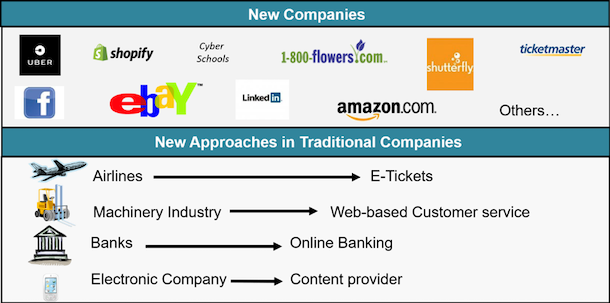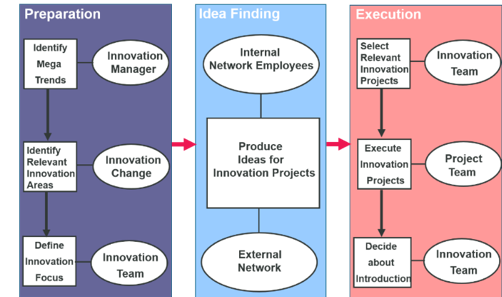This question matters – now more than ever
Companies face daily new opportunities and threats in our fast changing digital world. Organizations have to establish a management discipline to integrate agile innovation into their business and realize the full potential of digital technologies and the power of the internet. The Discipline of Business Process Management (BPM) addresses this need. Correctly set up, it establishes an agile and focused innovation capability in an organization. The BPM-Discipline produces innovation in form of new impactful processes and organizes the way other innovations are developed and rolled out. It is crucial for getting best value from digital transformations [1].
This article discusses the relation between innovation and process management and shows how the discipline of BPM becomes a major enabler of innovation. It is important to discuss the connections between innovation and BPM since this is an area where I see many misunderstanding in academia as well as in practice. There are still many people who think BPM kills creativity and innovation. This is a huge misunderstanding. The right approach to the BPM-Discipline identifies the appropriate degree of freedom for people to deliver continuous and agile innovation that moves an organization forward – fast and at minimal risk. Process management helps to enable new high performing processes in digital transformation initiatives [2].
According to Wikipedia [3] widely used definitions of innovation include the following:
- the introduction of something new (Merriam-Webster Online)
- a new idea, method or device (Merriam-Webster Online)
- the successful exploitation of new ideas (Department of Trade and Industry, UK)
- change that creates a new dimension of performance (Peter Drucker, Hesselbein, 2002)
Hence innovation is about creating a business impact through something new. It is not just about inventing, for example a new technology. But it is about using this invention to create business value. Let’s look at an example: A German research institute, the Frauenhofer Institut, invented the MP3 format to digitize music. Hence, they are the inventor. However, they sold the resulting patent to Apple who created a business around this new way of delivering music, with the iTunes store, iPods and many other components. Apple is the innovator. They make money through the invention.
Process Innovation through BPM has a major Impact
In the last ten years more and more inventions were not about things but about business processes. People invented new processes and built a business around it [4]. This is called process innovation. Amazon, for example, did not invent the book. But they invented a new process to sell books and established their company based on this process innovation. In a further innovation step, they became a broader online retailer. And now they offer their retail platform to other companies so they can sell new products online. eBay did not invent the auction, but its online, easy-to-use processes increased the popularity of the auction and the opportunity to make money with it. This is again a process innovation as the basis for a new business. LinkedIn and Facebook invented new processes to manage relationships and personal networks. Uber introduced new convenient processes for individual public transportation Think of all the online travel tools to book hotels, flights, or cars. They are all based on process innovation.
Traditional companies are also focusing more and more on process innovation. For example, enterprises in the machinery industries offer more convenient and reliable service processes based on Internet connections to their clients or directly to the delivered equipment. Airlines have simplified the ticketing process to reduce cost and increase, or at least stabilize, service levels through online ticketing. This is a process innovation that eventually became the standard, hence an industry best practice. Banks reduce cost and improve their service levels through online banking. Engineering company replace traditional prototyping through appropriate simulation and related development processes.
Examples for the significant impact of business process innovation are shown in Fig. 1.

Fig. 1 Examples of business process innovation in different organizations and industries
Other forms of innovation require in many cases a process innovation [5], too. Innovative business models are enabled through appropriate processes that support the requirements of new markets or new value propositions. Technology innovation requires new processes to sell, produce and maintain resulting new products and services. Process innovation is often the enabler of other forms of innovation.
All those cases of process innovation show that there is a direct relation between a new or modified business process and an innovation. There is a new value delivered to the client at the end of the process, new activities are carried out, maybe in a different sequence and with different technology support, or the starting trigger of the process has changed. Managing an innovation means here managing a new business process.
The Innovation Process also needs BPM
In addition, there is a second core reason why business processes are important for innovation. All forms of innovation are influenced through the business process that creates and manages them: the ”innovation process”. To come up systematically with an innovation you need to carry out a process that delivers at the end the innovation as result [4]. This process must be defined, implemented, executed, and controlled just like any other business process. It goes through the same process life cycle.
A generic example of one such an innovation process is shown in Fig. 2. The process develops from the preparation of an innovation initiative, to the “idea finding” activities, and finally to the execution of the innovation idea. The innovation manager identifies relevant mega trends and, on the basis of those, the relevant innovation fields. These innovation fields guide the definition of the company-specific innovation focus. This focus directs the “idea finding, using internal and external resources. The innovation ideas are evaluated, and the most interesting ones become innovation projects. These projects develop prototypes and business cases on the basis of the innovation idea. Then, the innovation team can decide which innovation ideas will be brought to market, or the ideas that will actually become innovations.

Fig. 2 Example of an innovation process
Such innovation processes can be rather complex. In many cases they are configured based on specific requirements of an innovation initiative. A biologics company, for example, has defined an overall comprehensive research and development business processes. However, after identification of an innovation idea, the following process steps are adjusted to the specifics of this initiative which often simplifies and accelerates the process.
In order to achieve planned and ongoing innovation the innovation process needs to be defined and managed properly. Resulting process innovation needs to be realized fast and effectively. The discipline of Business Process Management (BPM) becomes the key enabler of innovation [6] in the digital world.
References
[1] Antonucci, Y., Fortune, A., Kirchmer, M.: An examination of associations between business process management capabilities and the benefits of digitalization: all capabilities are not equal. In: Business Process Management Journal, Vol. ahead-of-print No. ahead-of-print.
[2] Kirchmer, M.: Accelerating Digital Transformation through Process Reference Models. In: https://www.cxoanalysis.com/accelerating-digital-transformation-through-process-reference-models/, July 28th, 2020.
[3] Wikipedia (ed.): Innovation. In: Wikipedia.org (2020).
[4] Kirchmer, M.: High Performance through Business Process Management – Strategy Execution in a Digital World. 3rd edition, Berlin, New York, e.a. 2017 (in publication by Springer)
[5] Davila, T, Epstein, M J, Shelton, R: Making Innovation Work. Wharton School Publishing, Upper Saddle River (2006)
[6] Franz, P., Kirchmer, M.: Value-driven Business Process Management – The Value-Switch for Lasting Competitive Advantage. New York, 2012.

















